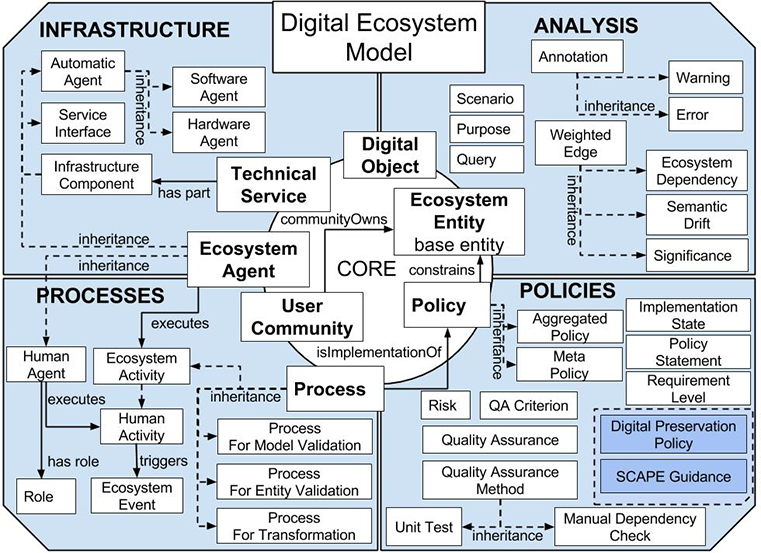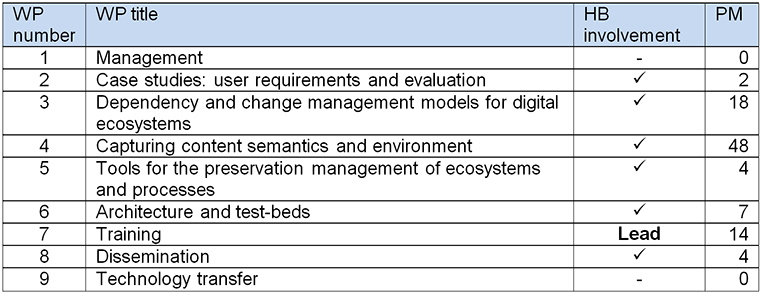PERICLES

Promoting and Enhancing Reuse of Information throughout the Content Lifecycle taking account of Evolving Semantics (PERICLES)
What is PERICLES?
PERICLES was an integrated four-year project (2013-2017) funded by the European Union under its Seventh Framework Programme (ICT Call 9). It addressed work programme objective ICT-2011.4.3 Digital Preservation. The aim was to address the challenges of ensuring that digital content remains accessible in an environment that is subject to continual change. The challenges encompass not only technological change, but also changes in semantics, academic or professional practice, or society itself, which can affect the attitudes and interests of the various stakeholders that interact with the content.
PERICLES took a ‘preservation by design’ approach that involved modelling, capturing and maintaining detailed and complex information about digital content, the environment in which it exists, and the processes and policies to which it is subject. PERICLES addressed these preservation challenges in two domains: digital artworks, such as interactive software-based installations, and other digital media from Tate's collections and archives; and experimental scientific data originating from the European Space Agency and International Space Station.
The project delivered a portfolio of models, services, tools and best practice for the support of preservation ecosystem and lifecycle management. Broader take-up of the project’s results was encouraged through Communities of Practice. The University of Borås has been one of eleven partners active in the project.
PERICLES and Modelling Digital Ecosystems
The core aspect of the model-driven approach developed in PERICLES is that of modelling digital ecosystems on the basis of our Linked-Resource-Model (LRM) that describes dependencies within the ecosystem. Basically this model covers all parts of an ecosystem, and can then be refined by domain specific ontology to describe domain workflows or complex objects.

Figure 1: A graphic model of the digital eco system, developed by Biermann, Johannes; Eggers, Anna; Corubolo, Fabio; Waddington, Simon
The University of Borås' role in PERICLES
The researchers and educational staff at HB have been involved in different Work Packages (WPs) as follows:

Figure 2. Involvement of researchers at the University of Borås, split up over Work Packages (WP) and Person Months (PM)
Research and Technical Development (RTD)
The primary investigator (PI) at the University of Borås has been Professor Sándor Darányi who has led the HB participation in general and the RTD team in particular.
A research focus for the HB researchers has related to “semantic decay” of digital assets or understanding of the changes that may emerge in uses of terminology. In this work the concept of semantic drift has been central. Semantic drift (also often referred to as “semantic change” or “evolving semantics”) is an active and growing area of research that observes and measures the phenomenon of changes in the meaning of concepts within knowledge representation models, along with their potential replacement by other meanings over time. Understanding this phenomenon and being able to anticipate trends in changing terminology use plays a central role in the management and long-term access and reuse of digital collections.
At HB, the physical metaphor of “vector field” was utilized in the study of semantic drift, and among others, a high performance machine learning algorithm (Somoclu) for the training of extremely large emergent self-organizing maps for exploratory data analysis was developed. For this, term distances were used as a measure of semantic relatedness and accordingly a new perspective for experimentation was created by using gravitation as a metaphor to express changes in the semantic content of a vector field.
There are numerous publications related to this research and the tool Somoclu is accessible as an open source piece of software via GitHub. Learn more about both Somoclu and the PERICLES research conducted within HB by visiting the publication tab.
Training
The Training Work Package of the project has been led from the University of Borås by Dr. Nasrine Olson. The HB training team has consisted of a number of different members based on availability and expertise required over time.
An aim of the HB training team has been to ensure effective management of the training activities as well as sharing knowledge about the PERICLES results with a multitude of audiences, through various training activities and engagements, while observing the set resource and time constraints. As part of this, different ideas were investigated, structures were put in place, and content designs were drawn up and implemented. Examples include creation of a structure for what we have called PERICLES Modular Training Package (PMTP), establishment of a PhD course, and design of a PERICLES MOOC. Organizing various events, development of training material, contributing to the content of the PMTP and MOOC, and facilitating module creations by other partners has also been included in our efforts.
The establishment of these web-pages is another step in the efforts by the HB training team in order to enable a broader access and continued use of the material produced by the collaborative efforts of the broader PERICLES training team.
Project partners
KCL - King´s College London - Coordinator
Website: http://www.kcl.ac.uk
HB - The University of Borås
Website: http://www.hb.se/
CERTH - Informations Technologies Institute
Website: http://mklab.iti.gr
DOT - Dotsoft SA
Website: http://www.dotsoft.gr
UGOE - Georg-August-Universität Göttingen
Website: http://www.uni-goettingen.de/en/1.html
ULIV - The University of Liverpool
Website: http://www.liv.ac.uk/
SpaceApps - Space Applications Services NV
Website: http://www.spaceapplications.com/
XEROX - Xerox SAS
Website: http://www.xrce.xerox.com
UEDIN - The University of Edinburgh
Website: http://www.epcc.ed.ac.uk/
TATE
Website: http://www.tate.org.uk
BUSOC - Belgian User Support and Operations Centre
Website: http://www.busoc.be/

